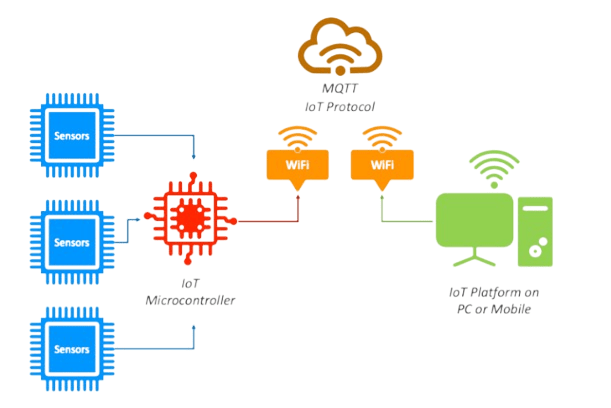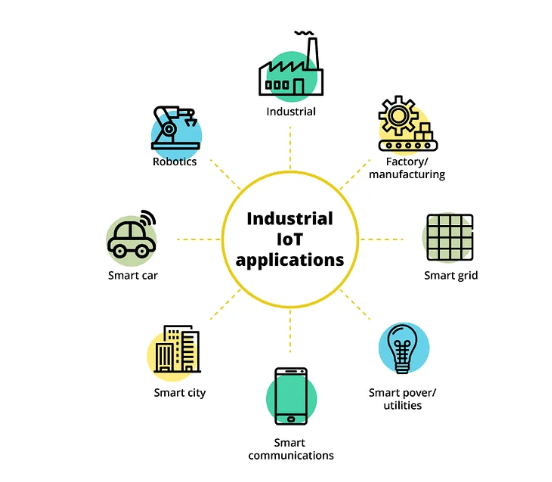
- Introduction to IoT
- How IoT Works
- Key Components of IoT Systems
- Smart Home Applications
- Industrial IoT (IIoT)
- IoT in Healthcare
- IoT in Transportation and Logistics
- IoT in Agriculture
- IoT in Smart Cities
- Future Trends in IoT
- Conclusion
Introduction to IoT
The Internet of Things (IoT) is a concept that refers to the interconnection of everyday objects through the internet, enabling them to send, receive, and exchange data. These objects, or “smart devices,” are equipped with sensors, software, and other technologies that allow them to interact with each other and with external systems, often in real-time. IoT is transforming various industries, enabling automation, increasing efficiency, and improving the quality of life for individuals and businesses alike. The development of IoT has been driven by advancements in wireless communication, sensor technologies, cloud computing, and data analytics. By integrating smart devices with the internet, IoT allows for the collection and analysis of vast amounts of data that can be used to optimize operations, enhance decision-making, and create new services.
How IoT Works
At its core, IoT operates through the following key components:
- Devices/Sensors: The “things” in IoT, these are physical objects embedded with sensors and software. These devices collect data (e.g., temperature, motion, light) from their environment and send it to other systems for processing.
- Connectivity: IoT devices require a communication channel to transmit data to other devices, servers, or the cloud. This can be achieved using a variety of network technologies, including Wi-Fi, Bluetooth, Zigbee, 5G, and cellular networks.
- Data Processing: The data collected from IoT devices is sent to a central system or cloud-based platform, where it is processed. This stage may involve analysis, filtering, and aggregation of data to derive meaningful insights.
- Action: Based on the processed data, the IoT system can trigger specific actions. For example, if a smart thermostat detects a drop in temperature, it may automatically turn on the heating system. Additionally, businesses can use the insights from IoT data to make better decisions.
- User Interface: IoT systems often provide an interface (such as a mobile app or web portal) for users to interact with and monitor their connected devices. This allows for real-time monitoring, alerts, and manual control of IoT devices.
- Sensors and Actuators: Sensors collect data from the physical environment (e.g., temperature, pressure, humidity), while actuators perform actions based on commands (e.g., turning on a light or adjusting a valve).
- Connectivity: Connectivity refers to the communication infrastructure that enables IoT devices to connect with each other or with the cloud. This can be achieved through wired or wireless technologies, including Bluetooth, Wi-Fi, cellular, and LPWAN (Low Power Wide Area Network) technologies like LoRa and NB-IoT.
- Data Processing and Storage: This component involves cloud-based platforms or edge devices that process and store the data collected from sensors. Platforms like AWS IoT, Microsoft Azure IoT, and Google Cloud IoT provide tools for managing and analyzing IoT data.
- Data Analytics: IoT data is often analyzed to derive insights and make informed decisions. Data analytics can take place on the edge (near the device) or in the cloud, using machine learning, artificial intelligence (AI), and other analytical tools to process the data.
- Security: Security is a critical component of IoT systems, as they involve sensitive data and connected devices. Measures such as encryption, secure authentication, and network monitoring are essential to protect IoT systems from cyber threats.
- Wearable Health Devices: Devices such as fitness trackers, smartwatches, and ECG monitors allow patients to monitor their health metrics, including heart rate, sleep patterns, and physical activity. These devices can provide real-time data to both patients and healthcare providers.
- Remote Patient Monitoring: IoT devices can monitor patients’ vital signs, such as blood pressure, glucose levels, and oxygen saturation, in real time. This allows healthcare providers to track patient health remotely and intervene when necessary.
- Smart Medical Equipment: IoT-enabled medical devices, like infusion pumps and ventilators, can provide detailed data on usage, performance, and maintenance needs. This helps improve patient safety and reduces the risk of equipment failure.
- Smart Hospitals: IoT technology is used to optimize hospital operations by tracking equipment, medications, and staff availability. This enables better resource allocation and reduces the risk of human error.
- Fleet Management: IoT devices can monitor the location, fuel usage, and maintenance needs of vehicles in a fleet. This enables logistics companies to improve fuel efficiency, reduce downtime, and ensure timely deliveries.
- Smart Traffic Management: IoT sensors and cameras embedded in roadways can collect real-time data on traffic conditions, enabling cities to manage traffic flow more effectively and reduce congestion.
- Cargo Tracking: IoT-enabled sensors placed in cargo containers can monitor the temperature, humidity, and condition of goods in transit. This is especially important for perishable goods and pharmaceuticals.
- Autonomous Vehicles: IoT is integral to the development of autonomous vehicles, providing real-time data on vehicle location, speed, and environmental conditions to ensure safe operation.
- 5G Integration: The rollout of 5G networks will enhance IoT capabilities by providing faster, more reliable communication for IoT devices.
- Edge Computing: Edge computing will allow IoT devices to process data locally, reducing latency and bandwidth usage, while improving real-time decision-making.
- AI and Machine Learning: IoT systems will increasingly integrate AI and machine learning to provide predictive analytics, automation, and smarter decision-making.
- Blockchain: Blockchain technology could enhance the security and transparency of IoT systems by enabling decentralized, tamper-proof transactions.

Key Components of IoT Systems
Smart Home Applications
Smart home devices are among the most popular applications of the Internet of Things (IoT), significantly enhancing the convenience, energy efficiency, and security of residential living spaces. These devices offer seamless automation and remote control, making homes smarter and more efficient. Smart thermostats, such as the Nest thermostat, can learn a homeowner’s schedule and preferences, automatically adjusting heating and cooling systems to save energy and reduce costs. Smart lighting systems enable users to control the brightness and color of their lights remotely through smartphone apps or voice commands, adding both convenience and customization. Smart security systems, including IoT-enabled cameras, doorbells, and motion sensors, enhance home safety by providing real-time alerts and live video streams to users’ smartphones. These systems even allow homeowners to interact with visitors or monitor activity remotely. Additionally, smart appliances like refrigerators, washing machines, and ovens come with IoT capabilities that offer remote control, diagnostics, and energy management features. Voice assistants such as Amazon Alexa, Google Assistant, and Apple Siri further streamline the smart home experience by enabling users to control multiple devices using simple voice commands. Overall, IoT-powered smart home devices deliver greater convenience, efficiency, and peace of mind to homeowners.
Industrial IoT (IIoT)
The Industrial Internet of Things (IIoT) refers to the use of IoT in industrial settings, such as manufacturing, energy, and logistics. IIoT is transforming industries by improving efficiency, reducing costs, and enabling predictive maintenance. IoT sensors embedded in machinery can monitor conditions like temperature, vibration, and pressure. By analyzing this data, companies can predict when equipment is likely to fail and perform maintenance before a breakdown occurs, reducing downtime and repair costs. IoT-enabled RFID tags and GPS devices can be used to track assets in real-time, improving inventory management, logistics, and supply chain efficiency.

IoT devices can monitor operations remotely, allowing for better control and optimization of industrial processes. This is especially useful for industries with geographically dispersed assets, such as oil and gas or mining. IoT systems can automate industrial processes by controlling machinery, adjusting parameters, and ensuring optimal performance. For example, automated assembly lines and robotic systems are commonly used in manufacturing to improve production efficiency.
IoT in Healthcare
IoT has a transformative impact on the healthcare industry, improving patient care, monitoring, and administrative efficiency. Common IoT applications in healthcare include:
IoT in Transportation and Logistics
IoT is revolutionizing the transportation and logistics industry by enabling real-time tracking, improving fleet management, and optimizing supply chains. Key applications of IoT in transportation and logistics include:
IoT in Agriculture
IoT technology is revolutionizing agriculture by enabling precision farming and optimizing the use of resources. Through advanced sensor networks and real-time data collection, farmers can make smarter decisions, enhance productivity, and reduce waste. One key application is smart irrigation, where IoT sensors monitor soil moisture levels and weather conditions, allowing farmers to optimize irrigation schedules and minimize water waste. Crop monitoring is another significant use case, as IoT sensors track factors such as soil quality, temperature, and humidity, providing farmers with real-time insights to make informed decisions on crop management. Livestock monitoring has also been transformed with IoT-enabled collars and tags, which track the health, location, and activity levels of animals. This helps farmers improve animal welfare and boost productivity. Additionally, automated machinery, powered by IoT technology, can control agricultural equipment such as tractors and harvesters, enabling automation and reducing labor costs. Overall, IoT in agriculture enhances efficiency, sustainability, and profitability, making farming operations more data-driven and precise.
IoT in Smart Cities
IoT technology plays a vital role in the smart city concept by leveraging connected technologies to optimize urban environments. It enhances efficiency, sustainability, and quality of life through real-time data collection and analysis. One key application is smart lighting, where IoT-based street lighting systems adjust brightness according to real-time conditions, boosting energy efficiency and reducing operational costs. Waste management is another area transformed by IoT, with smart sensors placed in trash bins to detect when they are full. This allows city services to optimize waste collection routes and schedules, reducing unnecessary pickups. In public transportation, IoT enables real-time tracking of vehicles, providing data on location and occupancy, which helps improve scheduling and enhances the passenger experience. Additionally, environmental monitoring with IoT sensors helps track air quality, temperature, and noise levels in urban areas. This data supports city planners in making informed decisions to improve the urban living environment. Overall, IoT-powered smart cities lead to better resource management, improved public services, and enhanced citizen satisfaction.
Future Trends in IoT
The future of IoT is bright, with innovations poised to transform industries and improve lives. Trends to watch for include:
Conclusion
The Internet of Things (IoT) has emerged as a transformative technology, revolutionizing industries and everyday life through smart, interconnected devices. From enhancing home automation and healthcare to optimizing industrial processes and urban infrastructure, IoT is driving efficiency, automation, and innovation across multiple domains. Despite its immense benefits, IoT also presents significant challenges, particularly in security and privacy. As the number of connected devices continues to grow, robust security measures, standardized protocols, and continuous advancements in AI and edge computing will be crucial in shaping the future of IoT. Looking ahead, the integration of 5G, AI, and blockchain will further expand the potential of IoT, making systems more intelligent, responsive, and secure. As businesses and governments increasingly adopt IoT solutions, the demand for skilled professionals in IoT development, data analytics, cybersecurity, and system architecture will continue to rise. In conclusion, IoT is not just a technological evolution but a fundamental shift in how we interact with the world. With ongoing innovation and strategic implementation, IoT will continue to enhance efficiency, productivity, and quality of life, shaping a smarter and more connected future.





